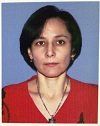д-р мед. наук, зав. отделом биохимии с группой микробиологии АО «Республиканский специализированный центр хирургии им. В. Вахидова», 700115, Республика Узбекистан, г. Ташкент, ул. Фархадская, 10
Биомаркеры системного воспаления и динамика липидного профиля при различной степени ожирения
АННОТАЦИЯ
В статье обсуждаются изменения липидного спектра плазмы крови и биомаркеры системного воспаления (С-реактивный белок (СРБ), интерлейкин-6 (ИЛ-6), фактор некроза опухоли альфа, фибриноген) при различной степени ожирения, а также у лиц с избыточной массой тела. Обследовано 76 женщин в возрасте 49,6±2,8 лет, некурящих, имеющих избыточную массу тела (индекс массы тела – ИМТ=28,2± 0,4 кг/м2) и ожирение I–III степени. Установлено, что снижение липопротеинов высокой плотности и увеличение триглицеридов отмечается у лиц с избыточной массой тела, а ожирение II и III степеней характеризуется практически одинаковой выраженностью дислипидемии. Обнаружены повышенные концентрации СРБ, ИЛ-6, увеличение моноцитов крови, что указывает на развитие системного воспаления при наличии избыточного веса и ожирении. Корреляционный анализ (n=76) показал, что имеется отрицательная корреляционная связь средней силы между уровнем липопротеинов высокой плотности (ЛПВП) и окружностью талии (ОТ): (r= - 0,42), тогда как между ЛПВП и ИМТ эта связь была слабой (r= - 0,18). Связи между уровнем триглицеридов (ТГ) и ИМТ; ТГ и ОТ характеризовались как слабые положительные: r=0,14 и r=0,26 соответственно. Обнаружена достоверная положительная корреляционная связь средней силы между ОТ и СРБ (r=+0,57) и отрицательная, средней силы связь между ОТ и ЛПВП (r= - 0,43) при ожирении II степени. Это свидетельствует о зависимости параметров липидного обмена и уровня СРБ от окружности талии при ожирении.
ABSTRACT
Biomarkers of a system inflammation (C-reactive protein - CRP, interliykin-6 – IL-6, tumor necrosis factor alpha, fibrinogen, whole blood count) and blood lipids spectrum changes at patients with various degree of obesity and also at persons with overweight are discussed in the article. It have surveyed 76 women in the middle age of 49,6±2,8 years old, all of patients were not smoking, with overweight (body mass index – BMI=28,2±
It is established, that decreasing of triglycerides, increasing of high density lipoproteins appears already at overweight; II and III classes of obesity are characterized by identical expressiveness of dyslipidemia. High concentration of CRP, IL-6 and monocytes are found out in persons with overweight and obesity that specifies development of a system inflammation. The correlation analysis (n=76) has shown, that there was a negative correlation connection of average force between a high density lipoproteins (HDL) level and waist circumference (WC): (r = - 0,42) whereas correlation connection between HDL and BMI was negative and weak
(r = - 0,18). Connections between a level of triglycerides (TG) and BMI; TG and WC were characterized as weak positive: r=0,14 and r=0,26 accordingly. There were positive with overage force correlation connection between WC and CRP (r=+0,57); negative, average force correlation connection between WC and HDL (r= - 0,43) at II class obesity. This data suggests that parameters of lipidomic profile and CRP depends on WC at obesity.
Список литературы:
References:



